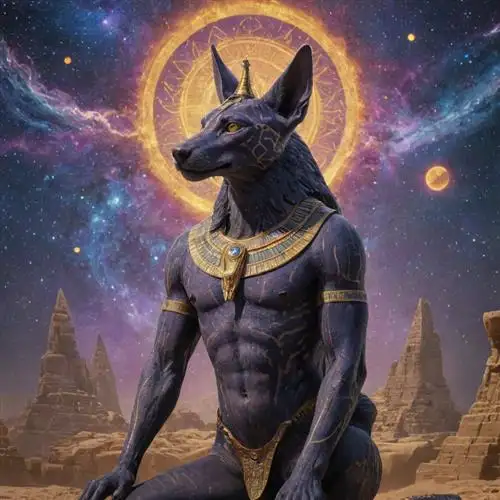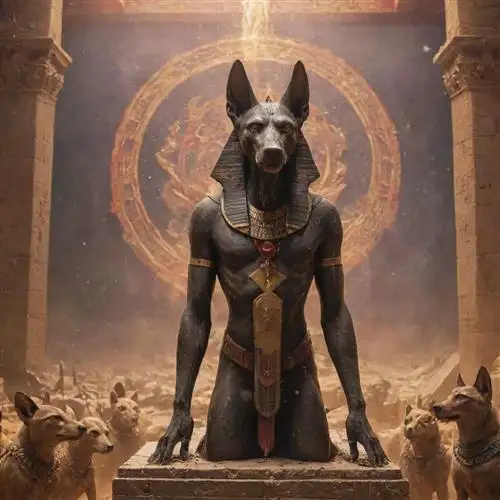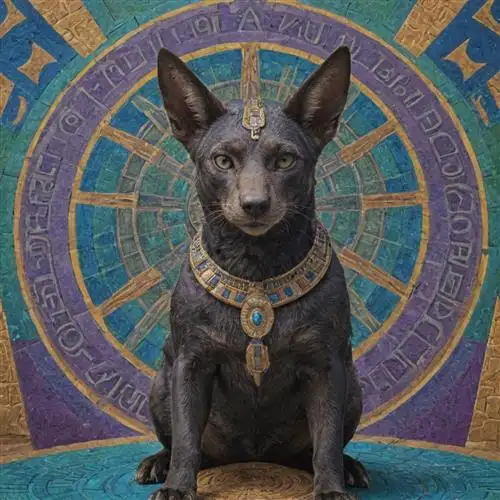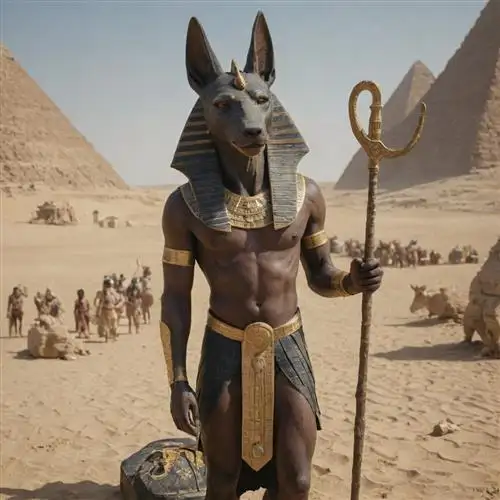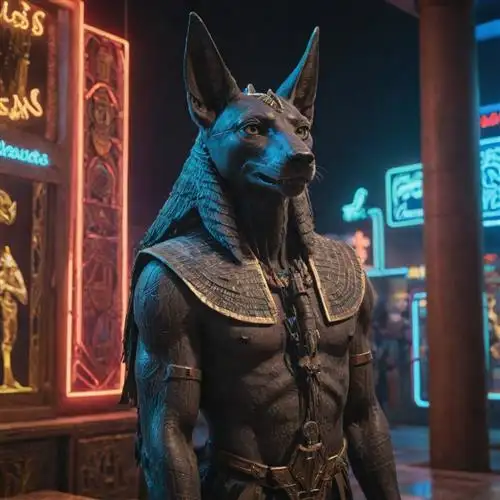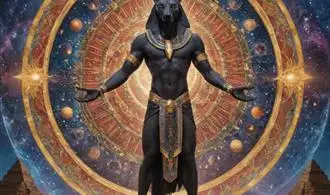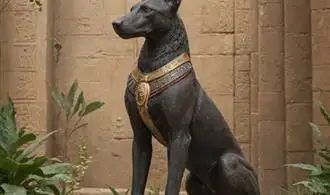
The Mythical Origins of Anubis
Anubis, the enigmatic jackal-headed deity, has captivated the imaginations of people for millennia. Rooted in the rich tapestry of ancient Egyptian mythology, the origins of Anubis' significance and symbolic representation are deeply intriguing. As one of the most prominent figures in the Egyptian pantheon, understanding the mythical foundations of this enigmatic deity can offer unparalleled insights into the beliefs and practices of the ancient Egyptians.
At the core of Anubis' mythological origins lies his role as the god of the dead and the afterlife. Believed to be the son of the god Ra and the goddess Nephthys, Anubis was tasked with overseeing the intricate process of mummification and guiding the souls of the deceased through the dangerous journey of the underworld. This responsibility, which was central to the Egyptians' elaborate funerary rituals, cemented Anubis' status as a pivotal figure in the Egyptian belief system.
The jackal-headed form of Anubis is believed to hold significant symbolic meaning. The jackal, a scavenger known to frequent cemeteries and burial sites, was associated with the liminal spaces between life and death. This connection to the realms of the dead and the ability to traverse the boundary between the living and the deceased made the jackal an apt representation for Anubis, the guardian of the dead.
Moreover, the color black, which often characterized Anubis' depiction, held deep significance in ancient Egyptian mythology. Black was symbolic of the fertile soil of the Nile River, as well as the color of the decomposing bodies that Anubis was tasked with mummifying. This duality of life and death, decay and regeneration, further emphasized Anubis' role as a mediator between the physical and the spiritual realms.
The mythical origins of Anubis also shed light on the complex and multilayered nature of ancient Egyptian religion. As the pantheon evolved over time, Anubis' relationship with other deities, such as Osiris, the god of the underworld, and Anubis' father, Ra, the sun god, became increasingly intricate. These interconnections highlight the dynamic and ever-changing nature of the Egyptian belief system, which was constantly adapting to the needs and beliefs of the people.
The Significance of Anubis in Ancient Egyptian Funerary Rites
The significance of Anubis in ancient Egyptian funerary rites cannot be overstated. As the jackal-headed god associated with mummification and the afterlife, Anubis played a vital role in the journey of the deceased from this world to the next. His presence was intrinsically linked to the most sacred and transformative moments of the Egyptian funerary process.
At the heart of Anubis' importance was his role as the guardian of the dead. He was believed to oversee the process of mummification, ensuring the proper preservation of the body and the soul's safe passage to the afterlife. The jackal-like features of Anubis were symbolic of his keen senses and ability to navigate the treacherous realms of the underworld, guiding the deceased through the dangers that awaited them.
Furthermore, Anubis was responsible for the critical weighing of the heart ceremony, where the deceased's heart was weighed against the feather of truth. This pivotal moment determined the fate of the soul, with Anubis acting as the impartial judge, ensuring the deceased had lived a virtuous life. The outcome of this judgment was believed to directly impact the soul's ability to achieve the coveted state of eternal life in the afterlife.
Anubis' involvement in the funerary rites extended beyond the initial mummification and judgment processes. He was also believed to be present at the burial, overseeing the interment of the body and the placement of grave goods. This final stage of the journey was seen as a critical transition, with Anubis guiding the deceased into the next realm and providing protection and guidance throughout the afterlife.
The Iconography and Symbolism of Anubis
Anubis, the jackal-headed deity of ancient Egyptian mythology, holds a unique and profound significance that extends far beyond his role as the god of the afterlife. The iconography and symbolism associated with Anubis reveal a multifaceted and complex figure, one that offers invaluable insights for the living. Delving into the intricate details of Anubis's representation and the meanings they convey can provide a deeper understanding of the ancient Egyptian worldview and its relevance to the modern-day seeker.
The jackal, the animal with which Anubis is closely associated, holds a powerful symbolic meaning in Egyptian culture. Jackals were often observed near cemeteries and burial sites, scavenging the dead. This proximity to the realm of the dead, coupled with their nocturnal nature and keen senses, elevated the jackal to a revered status as a guardian and protector of the deceased. Anubis, by extension, became the embodiment of these qualities, serving as the guide and protector of the dead as they navigated the treacherous journey to the afterlife.
The distinctive black color of Anubis's skin is equally significant. Black was considered a sacred hue in ancient Egypt, often associated with the fertile soil of the Nile River and the regenerative powers of the earth. This connection to the generative forces of nature imbued Anubis with a deeper symbolism, representing not just the transition to the afterlife but also the cyclical nature of existence and the eternal renewal of life.
Anubis's iconography further emphasizes his multifaceted role. Depicted with the head of a jackal and the body of a human, Anubis is a liminal figure, occupying the threshold between the realms of the living and the dead. This hybrid form serves as a visual representation of Anubis's ability to traverse both the physical and the spiritual worlds, guiding the deceased through the process of mummification and facilitating their safe passage to the afterlife.
The distinctive posture and gestures associated with Anubis also hold profound symbolic meaning. Oftentimes, Anubis is shown kneeling or crouching, a posture that suggests a sense of vigilance, protection, and reverence. His outstretched arms, sometimes holding a was scepter or a flail, symbolize his role as a guardian and intermediary, wielding the power to guide and influence the fate of the deceased.
The Evolution of Anubis Worship Throughout Egyptian History
Anubis, the jackal-headed deity, has been a central figure in the pantheon of ancient Egyptian mythology for millennia. As the god associated with mummification, the afterlife, and the protection of the dead, Anubis' significance has evolved and transformed over the course of Egyptian history, reflecting the changing beliefs and practices of the ancient Egyptians.
During the Early Dynastic Period (c. 3100-2686 BCE), Anubis was revered as the primary deity responsible for the embalming and burial of the deceased. The jackal was seen as a sacred animal, closely associated with the underworld and the transition between life and death. Anubis was believed to guide the deceased through the dangerous journey to the afterlife, ensuring their safe passage and protection.
As Egyptian religious practices and beliefs became more sophisticated, the role of Anubis expanded. During the Old Kingdom (c. 2686-2181 BCE), Anubis' association with the mummification process became more prominent, and he was often depicted standing guard over the deceased, ensuring the proper preparation and preservation of the body for the afterlife.
In the Middle Kingdom (c. 2055-1650 BCE), the worship of Anubis gained further prominence, with the god becoming closely linked to the judgment of the dead in the underworld. Anubis was believed to weigh the heart of the deceased against the feather of truth, determining their worthiness to enter the eternal realm of the afterlife. This role as the guardian of the underworld and the judge of the dead solidified Anubis' importance in the Egyptian pantheon.
During the New Kingdom (c. 1550-1069 BCE), the worship of Anubis continued to evolve, with the god being increasingly associated with the protection and guidance of the deceased throughout their journey in the afterlife. Anubis was often depicted alongside other deities, such as Osiris and Isis, highlighting his central role in the complex and intricate beliefs surrounding the Egyptian afterlife.
The Enduring Legacy of Anubis in Modern Spirituality and Pop Culture
Anubis, the jackal-headed Egyptian god, has long held a captivating place in the spiritual and cultural imagination of people worldwide. Despite the passage of millennia, this powerful deity continues to exert a profound influence, inspiring modern spiritual seekers and permeating popular culture. Delving into the enduring legacy of Anubis, we uncover the unusual insights this ancient figure holds for the living.
At the heart of Anubis' enduring appeal lies his multifaceted role in the Egyptian pantheon. As the god of the dead, Anubis was responsible for guiding the souls of the deceased through the complex process of the afterlife. This duty, imbued with profound symbolism and ritual, has resonated with spiritual practitioners seeking to navigate the mysteries of mortality and the transition from life to death. Anubis' liminal position, straddling the realms of the living and the dead, has made him a potent symbol of transformation, rebirth, and the cyclical nature of existence.
In the modern era, Anubis' influence has extended far beyond the bounds of ancient Egyptian religion. Within the realm of modern spirituality, Anubis has become a revered figure among practitioners of Wicca, Paganism, and other occult traditions. These communities have embraced Anubis' associations with death, the afterlife, and the power of the subconscious, incorporating his iconography and mythology into their rituals and belief systems. The god's connection to the underworld and the mysteries of the unseen world have made him a powerful ally for those seeking to deepen their spiritual understanding and connection to the divine.
The impact of Anubis extends beyond the spiritual realm, permeating the realms of popular culture and the arts. In literature, film, and television, Anubis has been a recurring motif, often appearing as a symbol of mystery, power, and the allure of the unknown. From ancient Egyptian-inspired fantasy sagas to modern supernatural thrillers, Anubis' presence has captivated audiences, tapping into the collective fascination with the enigmatic and the otherworldly.
In the visual arts, Anubis' distinctive jackal-headed form has become an instantly recognizable symbol, inspiring the work of contemporary artists, designers, and illustrators. The god's striking visual representation, steeped in the rich iconography of ancient Egypt, has lent itself to a wide range of creative interpretations, from tattoo designs to high-fashion collaborations. This enduring visual appeal has further cemented Anubis' place in the cultural consciousness, ensuring his continued relevance and fascination in the modern era.
The Anubis phenomenon extends beyond the realms of spirituality and the arts, infiltrating various aspects of popular culture. The god's association with the afterlife, the occult, and the mysteries of the unseen world has made him a popular figure in video games, comic books, and even fashion accessories. This widespread appropriation of Anubis' image and symbolism reflects the deep-seated human desire to engage with the unexplained and the extraordinary, highlighting the timeless allure of this ancient Egyptian deity.

